
We've all been through it. You know, the moment you're about to dig into the best darn pile of spaghetti and meatballs you've ever seen.
Just as you twist your fork in the pasta, spear a mouth-watering meatball, and go in for the first savory bite ... the phone rings. "May I speak to Lindsay Kow-low-witch?" asks the telemarketer on the other end. "This is an important message regarding your oven preferences."
This frustrating interruption is exactly why we're here to discuss inbound lead generation. What is inbound lead generation? It's a solution that can save your business or organization from being that annoying, disruptive cold caller who is ruining spaghetti nights for pasta lovers all over the world.
Let's start with defining a lead, and then we'll get into what online lead generation is, why you need lead generation, how you qualify someone as a lead, how you generate leads, and why inbound lead generation is much more effective than simply buying leads.
What is a Lead?
Let's start with the basics. A lead is a person who has indicated interest in your company's product or service in some way, shape, or form.
In other words, instead of getting a random cold call from someone who purchased your contact information, you'd hear from a business or organization you've already opened communication with.
For example, maybe you took an online survey to learn more about how to take care of your car. If you got an email from the auto company that hosted the survey on their website about how they could help you take care of your car, it'd be far less intrusive and irrelevant than if they'd just called you out of the blue with no knowledge of whether you even care about car maintenance ... right?
And from a business perspective, the information the auto company collected about you from your survey responses would help them personalize that opening communication to meet the existing needs of the potential client.
What Is Lead Generation?
Lead generation is the process of attracting and converting strangers and prospects into those leads we just talked about.
Whenever someone outside the marketing world asks me what I do, I can't simply say, "I create content for lead generation." It'd be totally lost on them, and I'd get some really confused looks.
So instead, I say, "I work on finding unique ways to attract people to my business. I want to provide them with enough goodies to get them naturally interested in my company so they eventually warm up to the brand enough to want to hear from us!"
That usually resonates better, and that's exactly what lead generation is: It's a way of warming up potential customers to your business and getting them on the path to eventually buying.
Why Do You Need Lead Generation?
By showing an organic interest in your business, it's those strangers and prospects that are initiating the relationship with you -- versus you, the business, initiating the relationship with them. This makes it easier and more natural for them to want to buy from you somewhere down the line.
Within the larger inbound marketing methodology, lead generation falls in the second stage. It occurs after you've attracted an audience and are ready to actually convert those visitors into leads for your sales team. As you can see in the diagram below, generating leads is a fundamental point in an individual's journey to becoming a delighted customer of your business.
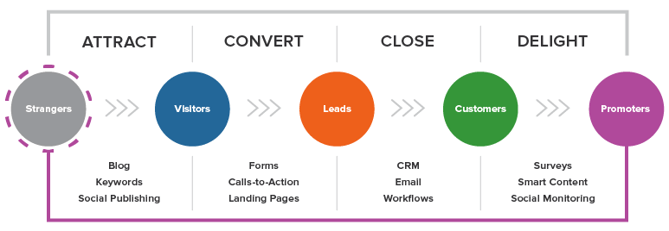
How to Qualify a Lead
As you now know, a lead is a person who has indicated interest in your company's product or service. Now, let's talk about the ways in which someone can actually show that interest.
Essentially, a sale lead is generated through information collection. That information collection could come as the result of a job seeker showing interest in a position by completing an application for the job, a shopper sharing contact information in exchange for a coupon, or a person filling out a form to download an educational piece of content, like an ebook, kit, podcast, tool, trial, or something else.
Below are just a few of the many ways in which you could qualify someone as a lead. Each of these examples also highlights the fact that the amount of information you can collect to qualify someone as a lead, as well as the that person's level of interest in your company, can vary. Let's assess each scenario:
- Job Application: Any individual filling out an application form is willing to share a lot of personal information because he/she wants to be considered for the position. Filling out that application shows their true interest in the job, therefore qualifying the person as a lead for the company's recruiting team.
- Coupon: Unlike the job application, you probably know very little about someone who has stumbled upon one of your online coupons. But if they find the coupon valuable enough, they may be willing to provide their name and email address in exchange for it. Although it's not a lot of information, it's enough for a business to know that someone has interest in their company.
- Content: While the download of a coupon shows an individual has a direct interest in your product or service, content (like an educational ebook or webinar) does not. Therefore, in order to truly understand the nature of the person's interest in your business, you'll probably need to collect more information -- you'll need enough information for a sales rep to actually understand whether the person is interested in your product or service, and whether they're a good fit.
These three general examples highlight how lead generation differs from company to company, and from person to person. You'll need to collect enough information in order to gauge whether someone has a true, valid interest in your product or service, but knowing how much information is enough information will vary depending on your business.
Let's look at Episerver, for example. They use web content reports for lead generation, collecting six pieces of information from prospective leads:
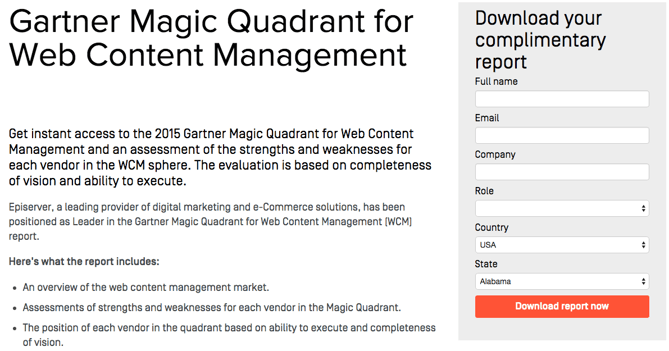
As you can see, Episerver asks for:
- Full Name: Basic information needed for communication with the to-be lead.
- Email: The email address will allow your business to communicate with the to-be
lead through your email marketing campaigns. - Company: This will give you the ability to research what the business does and how the lead might benefit from your product or service. (Mainly for B2B)
- Role: Understanding an individual's role in the business will help you understand how to communicate with them. Every brand stakeholder will have a different take and perspective on your offering. (Mainly for B2B)
- Country: Location information needed for qualifying the to-be lead and sending it to the correct sales team, if applicable.
- State: Location information needed for qualifying the to-be lead and sending it to the correct sales team, if applicable.
If you'd like to learn more intermediate-level tips on information collection and what you should ask for on your lead gen forms, read our post about it here. But we're getting ahead of ourselves. Now, back to the basics ...
How to Generate Leads: The Mechanics of Lead Generation
Now that we understand how lead generation fits into the whole inbound marketing methodology, let's review the actual components of the lead generation process.
Visitor: A visitor has discovered your business through one of your marketing channels, whether that’s your website, blog, or social media page. On any of these channels, you’ll need to have a ...
Call-to-Action (CTA): A call-to-action or CTA is an image, button, or message that calls website visitors to take some sort of action. When it comes to lead generation, this action is to navigate to a ...
Landing Page: A landing page is a web page a visitor lands on for a distinct purpose. While a landing page can be used for various reasons, one of its most frequent uses is to capture leads through ...
Forms: Forms are typically hosted on landing pages, although they can technically be embedded anywhere on your site. They consist of a series of fields (like in our example above) that collect information in exchange for an ...
Offer: An offer is the content or something of value that's being "offered" on the landing page. The offer must have enough value to a visitor to merit providing their personal information in exchange for access to it.
See how everything fits together?
(If you're looking for a free lead generation tool, take a look at HubSpot Marketing Free, which lets you set up contact and lead capture forms on your website and/or scrape contact info from your existing forms. It's really easy to set up.)
Once you put all these elements together, you can use your various promotional channels to link and drive traffic to the landing page so you can start generating leads. Here are some example pathways for lead generation:

Hold Up ... Why Not Just Buy Leads?
Marketers and salespeople alike want to fill their sales funnel -- and they want to fill it quickly. That's where the temptation to buy leads comes in. Buying sale leads, as opposed to generating them organically, is much easier and takes far less time and effort, despite being more expensive. So why shouldn't you just buy leads?
First and foremost, any leads you've purchased don't actually know you. Typically, they've "opted in" at some other site when signing up for something, and didn't actually opt in to receiving anything from your company. The messages you send them are therefore unwanted messages, and sending unwanted messages is intrusive, not inviting. (Remember that disruptive call I got when I was trying to eat my spaghetti? That's how people feel when they receive emails and other messages from people they didn't ask to hear from.)
If the prospect has never been to your website, indicated an interest in your resources, products, services, or even industry, then you’re interrupting them ... plain and simple.
If they never opted in to receive messages from you specifically, then there's a high likelihood they could flag your messages as spam. This is quite dangerous for you. Not only does this train their inbox to show only emails they want to see, but it indicates to their email provider which emails to filter out. Once enough people click flag your messages as spam, you go on a "blacklist," which is then shared with other email providers. Once you get on the blacklist, it’s really, really hard to get back off of it. In addition, your email deliverability and IP reputation will likely be harmed.
It's always, always, always better to generate leads organically rather than buy them. Read this blog post to learn how to grow an opt-in email list instead of buying one.
Lead Generation Trends & Benchmarks
So ... you're getting web traffic and generating leads. But how are you doing compared with other companies in your industry? How many leads should you really be generating?
It's tough to figure out whether your lead generation strategy is working if you aren't looking at industry data. That's why we partnered with Qualtrics to survey more than 900 marketers from all different industries in North America and Europe. Using this data, we created a demand generation report with data on website visitors, leads, opportunities, customers, and revenue.
For example, did you know that 74% of companies that weren’t exceeding revenue goals didn't know their visitor, lead, MQL, or sales opportunities numbers? How about that over 70% of companies not achieving their revenue goals generate fewer than 100 leads per month, and only 5% generate more than 2,500 leads per month?
For the in-depth reports, download our Demand Generation Benchmarks Report. Here are some highlights:
Cost per Lead, by Industry
The media and publishing industries report the lowest cost per lead, at $11–25. Software, information technology and services, marketing agencies, and financial services companies all report the highest average cost per lead, at $51-100.
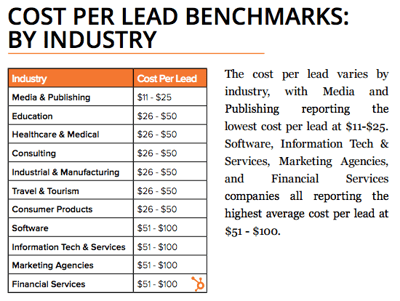
Leads Generated per Month, by Annual Revenue
Unsurprisingly, the more revenue a company has, the more leads they generate. The differences are most drastic at the highest and lowest end of the spectrum: 82% of companies with $250,000 or less in annual revenue report generating less than 100 leads per month, whereas only 8% of companies generating $1 billion in annual revenue report less than 100 leads per month.
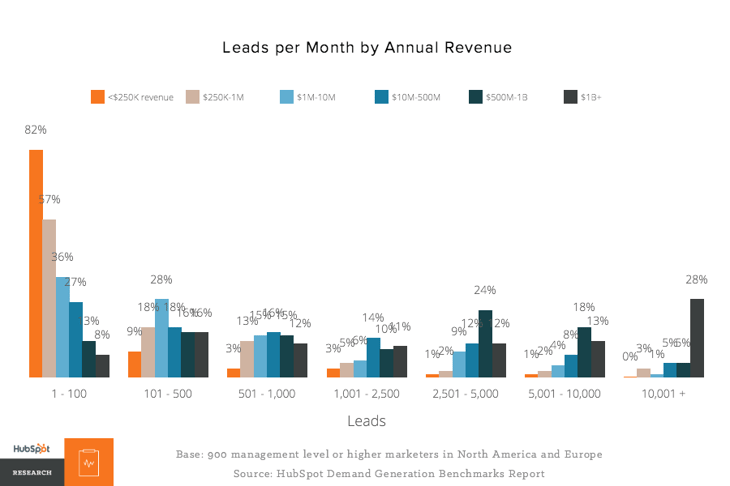
Leads per Month
We found that, in general, 58% of companies generated 500 leads per month or fewer and 71% generate 1,000 or fewer. However, as we saw previously, the companies having the most success are also the ones generating the most leads.
Here's how the data broke down by company size:
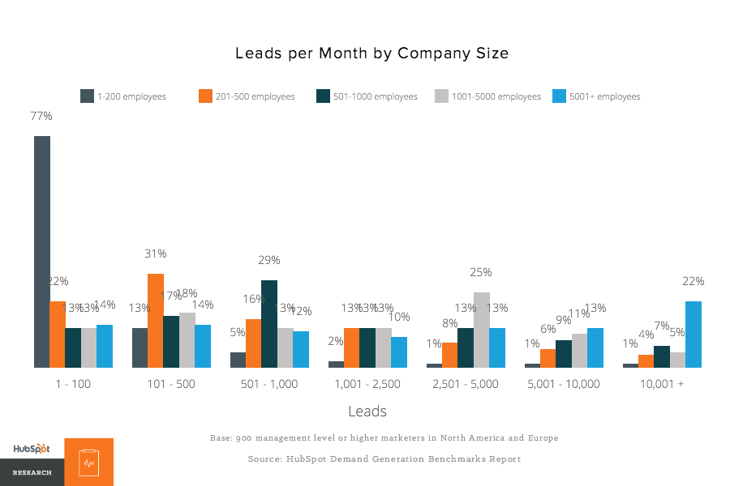
Lead Generation Software
We found that the most successful teams use a formal system to organize and store leads: 46% use Google Docs, 41% use marketing automation software, and 37% use CRM software. (HubSpot customers: Google Drive integrates both with HubSpot Marketing and with HubSpot CRM.)

Tips for Lead Generation Campaigns
In a given lead generation campaign, there can be a lot of moving parts. It can be difficult to tell which parts of your campaign are working and which need some fine-tuning. What exactly goes into a best-in-class lead generation engine?
Use the right lead generation tools.
As you saw in our data, the most successful marketing teams use a formal system to organize and store their leads. That's where lead generation tools and lead generation software comes in.
How much do you know about the people visiting your website? Do you know their names or their email addresses? How about which pages they visit, how they're navigating around, and what they do before and after filling out a lead conversion form?
If you don't know the answers to these questions, then chances are, you're having a hard time connecting with the people who are visiting your site. But these are questions you should answer -- and you can, too, with the right lead generation tools.
There are a few different tools and templates out there that'll help you create different lead gen assets you can put on your site:
- CTA Templates: 50+ free, customizable call-to-action (CTA) templates in PowerPoint that you can use to create clickable CTA buttons you can put on your blog, landing pages, and elsewhere on your site
- HubSpot Marketing Free: A free lead generation software tool from HubSpot that includes lead capture and contact insights features, which will scrape any pre-existing forms you have on your website and add those contacts to your existing contact database. It also lets you new pop-ups, hello bars, or slide-ins -- called "lead flows" -- that'll help you turn website visitors into leads immediately.
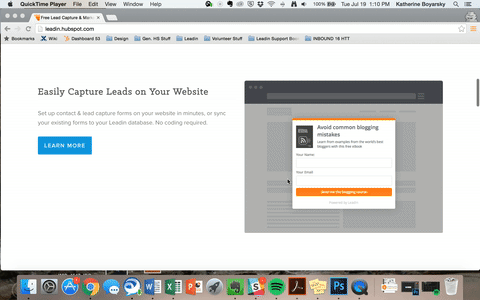
Example of a slide-in lead flow created using HubSpot Marketing Free.
- Hotjar: A great tool to help you understand what users want, care about, and do on your site using heatmaps, visitor recordings, analyses of your forms, feedback forms and surveys, and more.
- A form scraping tool that collects submissions on your website's existing forms, so you can consolidate all your leads into your contacts database regardless of which form visitors submit on your website. If you're a HubSpot customer, you can create and embed forms using HubSpot. Non-HubSpot customers can use a form creation tool like Contact Form 7, JetPack, or Google Forms, and then use HubSpot Marketing Free's Collected Forms feature to automatically capture these form submissions and put them in your contacts database.
Create amazing offers for all different stages of the buying cycle.
Not all of your site visitors are ready to talk to your sales team or see a demo of your product. Someone at the beginning of the buyer's journey might be interested in an informational piece like an ebook or a guide, whereas someone who's more familiar with your company and are near the bottom of the cycle might be more interested in a free trial or demo. Make sure you're creating offers for each phase and offering CTAs for these offers throughout your site.
Yes, it takes time to create valuable content that teaches and nurtures your leads down the funnel, but if you don't offer anything for visitors who aren't ready to buy, then they may never come back to your website. From checklists to templates to free tools, here are 23 ideas for lead generation content to get you started.
If you want to take personalization a step further for a higher conversion rate, try using smart CTAs on your webpages and blog posts. Smart CTAs are CTAs that detect where that person is in the buying cycle -- whether they're a new visitor, a lead, or a customer -- and change accordingly. Personalized CTAs convert a whopping 42% more visitors than basic calls-to-action.
Link your CTA to a dedicated landing page.
This may seem obvious to some of you, but you'd be surprised how many marketers don't create dedicated landing pages for their offers. CTAs are meant to send visitors to a dedicated landing page where they receive a specific offer.
Don't use CTAs to drive people to your homepage, for instance. Even if your CTA is about your brand or product (and perhaps not an offer like a download), you should still be sending them to a targeted landing page that's relevant to what they are looking for, whether it's a feature-specific landing page for your product, or something else. If you have the opportunity to use a CTA, send them to a page that will convert them into a lead.
If you want to learn more about how to build and promote high-converting landing pages, then download our ebook on optimizing landing pages for conversions.
Use social media strategically.
While marketers typically think of social media as best for top-of-the-funnel marketing, it can still be a helpful and low-cost source for lead generation. The key is using social media strategically for lead gen.
How do you do that? Start by regularly posting links to your Facebook, Twitter, LinkedIn, and other social media posts directly to the landing pages of high-performing offers. Make sure you make it clear to visitors that you're sending them to a landing page, though. That way, you're setting expectations fairly. Here's an example from one of our Facebook posts:
You can also do a lead generation analysis of your blog to figure out which posts generate the most leads, and then make a point of regularly linking posts to them, too.
Another way to generate leads from social media? Run a contest. They're fun and engaging for your followers, and they can also teach you a ton about them. It's a win-win. Read our step-by-step guide for growing your email list using social media contests here, which covers everything from choosing a platform, to picking a winner, all the way to analyzing your results.
Finally, take advantage of the lead gen opportunities each social media platform already gives you. For example, Facebook has a feature that lets you put a simple call-to-action button at the top of your Facebook Page, helping you send Facebook followers directly to your website. Here's an example from Canva's Facebook Page:
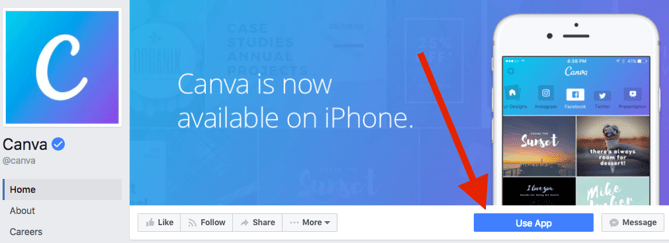
Twitter has Twitter Lead Gen Cards, which let you generate leads directly within a tweet -- without having to leave Twitter. A user's name, email address, and Twitter username are automatically pulled into the Card, and all they have to do is click "Submit" to become a lead. (HubSpot users: You can connect Twitter Lead Gen Cards to your HubSpot Forms. Learn how to do that here.)
If you're looking for more lead generation tips for social media, here are lead gen tips for Facebook and here are lead gen tips for Twitter.
There you have it, folks. Now that you know more about how to generate leads for your business, we recommend you try HubSpot's free lead generation tool. Use it to add simple conversion assets to your site (or scrape your existing forms), and then learn more about your site visitors and what content prompts them to convert.
The basics we've gone over in this blog post are just the beginning. Keep creating great offers, CTAs, landing pages, and forms -- and promote them in multi-channel environments. Be in close touch with your sales team to make sure you're handing off high-quality leads on a regular basis. Last but not least, never stop testing. The more you tweak and test every step of your inbound lead generation process, the more you'll improve lead quality and increase revenue.
Editor's Note: This post was originally published in July 2013 and has been updated for freshness, accuracy, and comprehensiveness.

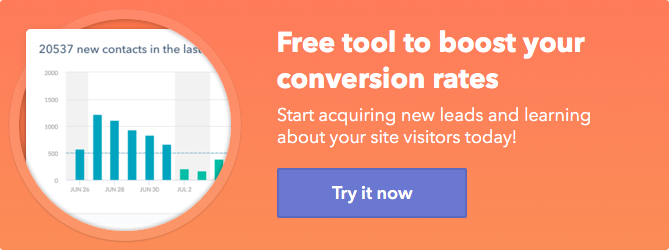
No comments:
Post a Comment